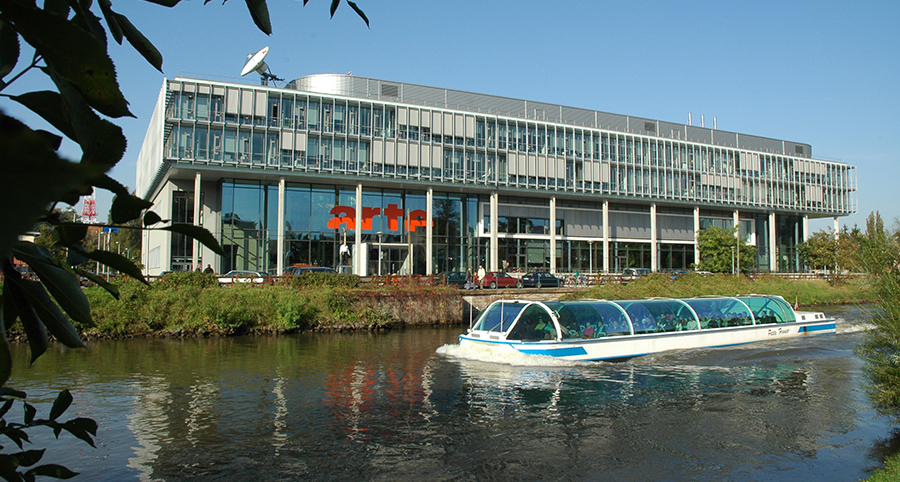ARTE GEIE’s headquarters are located in Strasbourg on the Franco-German border, in the vicinity of European institutions. The symbolism of the location is threefold: of success for a TV channel that has carved out its own distinctive identity in the European broadcast landscape, of cooperation between France and Germany and of an enthusiastic and resolute openness to all European nations.
Sustainability
ARTE is committed to sustainable development and to managing energy consumption across all operations at its Strasbourg headquarters.
As the first television channel in France to be ISO 50001 certified, ARTE is committed to taking the necessary measures to improve its energy efficiency by 40% by 2024 compared to its baseline year in 2013. The channel is analysing and optimising its most energy-intensive activities. It is working to raise awareness among all employees and to integrate energy criteria into its purchasing policy. Its energy performance has been improved by 29.04 % between 2014 and the end of 2022. Annual consumption has fallen from 8.2 GWh in 2013 to 4.1 GWh at the end of 2022. It has therefore fallen by 47.8 % in 2022 (compared to 2013) with a reduction of 72.6 % in gas and 38.4 % in electricity. This effort meets the objective of fighting global warming set by the European Union (Directive 2018/2002/EU).
More information on sustainability at ARTE →
Architecture on a human scale
ARTE’s corporate headquarters were inaugurated on October 13th 2003 in Strasbourg, close to the European Parliament, the Council of Europe and the European Court of Human Rights.
Located on the banks of the Ill river, between the city’s historic centre and the European district, ARTE HQ lies at the centre of a traditional residential district. The building, designed by architect Hans Struhk, displays clear, transparent lines and is harmoniously integrated into the existing environment. The construction of ARTE HQ is a successful example of Franco-German cooperation. In addition to a group of colleagues from the station, 37 construction companies and 11 experts and consultants from both sides of the Rhine took part in fulfilling the vision of architects Hans Struhk (Germany), Maechel Delaunay (France) and Paul Maechel (France).
Designed on a human scale, the architecture has resulted in a professional environment that is especially conducive to creativity. In addition to functional requirements, Hans Struhk has given considerable emphasis to nature. Examples of the four elements – earth, water, air and fire – are found everywhere in the building: the sky is reflected off the atrium’s unpolished basalt, and embellished by an impressive oak staircase. The hanging garden offers up an oasis of greenery, whilst the external walls of the studios and restaurant are lit up in a bold red. In addition, the workspaces are harmoniously set around two interior courtyards which serve as important meeting places and provide access to natural light.
A technological revolution: the all-digital era
The transmission system went through a technical revolution when ARTE moved into its new headquarters. Programmes were to be recorded and stored on computer servers, replacing the older tape method. Each element of the programs (audio and video, language versions, subtitles, photos, press releases, production rights, management) are digitized and saved to the servers for easy access from workstations. Actual broadcasts are made using these elements, without any recourse to the analogue medium.
Apart from the obvious short-term advantages (the significant improvement in the station’s performance in terms of productivity and general operating efficiency, more effective sharing of information, quicker transmission of programmes from the different production centers, and the elimination of the more fragile and limited storage capabilities of magnetic media, therefore saving time and space…), the new system facilitated greater ties between the station and the Internet (broadcasting programs directly onto the web, introducing remote pre-release viewing, interactivity with viewers, etc.)
This ‘evolutionary step’ in working methods took place gradually to allow staff the time to adapt. The culmination of these changes is found the new broadcast control room installed in 2012.
Project background
- October 1990: An Inter-State Treaty is signed between the French Republic and the states that comprise the Federal Republic of Germany, confirming that the European culture channel will have its headquarters in Strasbourg.
- March 1992: Designed by architects, Michel Moretti and Gérard Altorffer, ARTE moves into his first official building in rue de la Fonderie in the centre of Strasbourg. But faced with the channels growing needs, the building’s capacities are soon found to be insufficient, with teams divided between seven separate addresses
- March 1998: ARTE’s General Assembly decides to build a new headquarters on land provided by the City of Strasbourg, and located at the corner of rue Lauth and quai du Canon Winterer. This is in keeping with the aims of the Land Use Plan (P.O.S.), that insists the site be reserved for “projects related to Strasbourg’s European vocation”.
- October 1999: Following a European-wide tender, ARTE’s General Assembly decides on the project put forward by the Franco-German team of Hans Struhk and Paul Maechel for the construction of its new headquarters.
- May 2001: Catherine Tasca, French Minister of Culture and Communication, joins ARTE presidents Jobst Plog and Jérôme Clément in laying the first stone of the new ARTE headquarters in Strasbourg, close to the European institutions.
- April 2003: ARTE inaugurates its new headquarters in Strasbourg, close to the European institutions, in a building designed by the French-German team of Hans Struhk and Paul Maechel.
- September-October 2006: Unveiling of two works specially created for ARTE, “La grande ourse” (The Great Bear), by French artist Lydie Arickx and “Der Giraffenmann”/“L’homme-girafe” (Giraffe Man), a sculpture by German artist Stephan Balkenhol.

